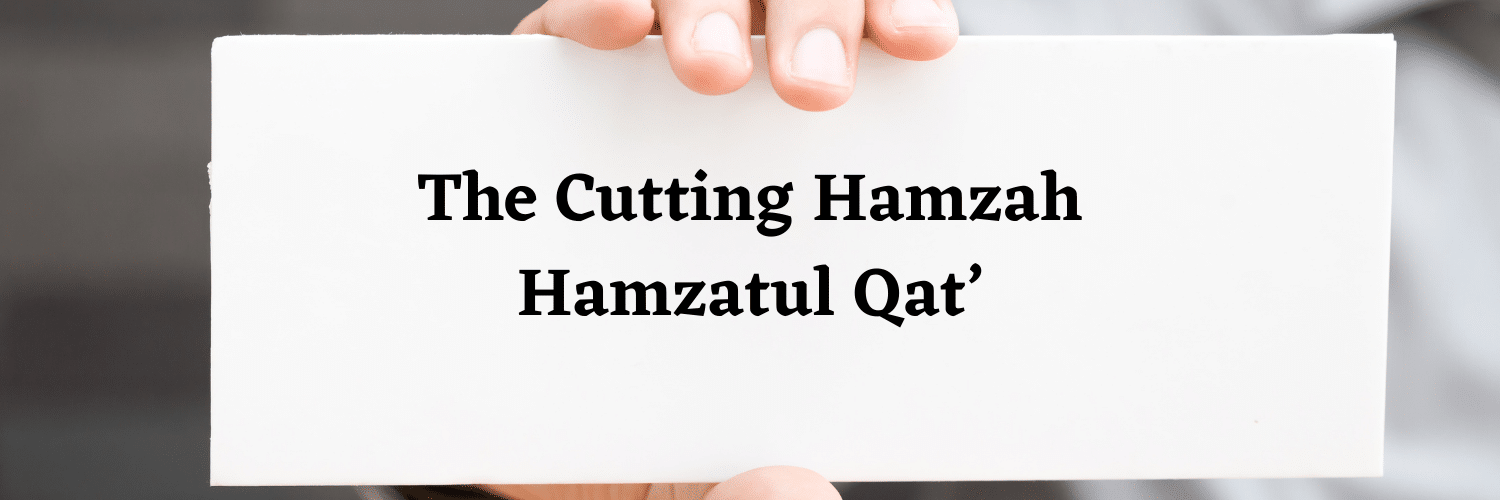Have you ever wondered why the latest and greatest things are referred to as “cutting edge”? Like, cutting edge technology, or cutting edge research… Are there such things as cutting edge words? What about cutting off people in mid-sentence? Mid-word? Is there anything cutting edge enough to do that? Maybe a cutting hamzah…
Hamzatul Qat’[1]: the cutting hamzah is represented by the following symbol ( ء ). It should not be mistaken with the letter alif ( ا ), but it should be noted that it often occurs on the alif ( أ or إ ). This post will cover some general rules about the hamzatul qat’, while also taking a close look at the letter itself.
The hamzatul qat’ sound is produced by cutting off the air stream at the top of the windpipe (then letting it go for a breath, of course!). It is similar to pressing the stop button on a tape player in mid-word.
The hamzatul qat’ can be found in a number of places within a word:
At the beginning it may appear as:
ءَأنْتُم أحْمَد
Ahmad A-antum
At the end of the word, it may appear on the line:
سَمَاءْ
Samaa’
The hamzatul qat’ also appears on the three voweled letters, and on a spike (commonly referred to as a “chair”) of it’s own.
On the alif, it can appear at the beginning of the word as shown previously, at the end of a word, or in the middle of a word:
سَأَلَ
Sa’ala
Appearing on the waaw under certain Arabic grammar rules, the hamzah looks like so:
مُؤْمِنَة
Mu’minah
The hamzah appears on the yaa at the end of the word as so:
بَرِيئْ
Baree’
Appearing on it’s own tooth, chair, or spike, the hamzah is written like so:
بِئْسَ
Bi’sa
From the above, we can observe that whenever a hamzatul qat’ enters on a harf madd, the harf madd is not sounded, rather the 2 vowels are cut simply into a fat-ha, dammah, or kasra. After all, it is the cutting hamzah!
Let’s observe some of the tajweed rules involved with this hamzah.
![]()
Hamzatul Wasl meets Hamzatul Qat’
When the hamzatul qat’ is preceded by a hamzatul wasl, there are two rulings.
If the hamzatul wasl is dropped, because the word starting with it is connected to the preceding word, then the hamzatul qat’ is sounded as per normal. Example,
الَّذِي اؤْتُمِنَ
Al-lathi-‘tumina
(read as الذِءْتُمِنَ )
If the hamzatul wasl is NOT dropped, because the reciter is starting at that word, then the hamzatul qat’ is dropped, and the harf madd it is “sitting on” is sounded for 2 counts. Example,
اؤْتُمِنَ
Oootumina
To break it down, the process is simple. The hamzah on the 2nd letter (i.e. the hamzatul qat‘) is “transferred” onto the hamzatul wasl, and the respective diacritic is assigned such that a madd badal is can then be sounded. Based on this process, the word above is read as أُوتُمِنَ
Another example is as follows. In this word, the hamzatul qat‘ is replaced by a yaa’ madeeyah such that the word “i-i-tinaa” beocomes
ائْتِنَا
Ieetinaa
Hamzatul Qat’ and Al-Madd Al-‘Iwad
When a word ends with hamzatul qat’, whether on a yaa, or on the line, the hamzatul qat’ must be voweled for two counts. Example,
بِنَاءً
Binaaa’aa (when stopping)
Hamzatul Qat’ precedes Hamzatul Wasl
There is one occurance of this in the Quran (where a hamzatul qat’ precedes a hamzatul wasl). This word has the “ease of pronunciation” rule applied to it, because it is very difficult for the tongue to pronounce. It also ties in with the grammar rule about the impermissiblity of two saakin letters being together.
أَأَعْجَمِيٌّ
A-a-‘jamee
(read as ءَءَعْجَمِيٌّ ) – this word is found in Fussilat (41:44)
It would be impossible to say it with both saakin on the hamzatul wasl and the ayn, as the hamzatul wasl cuts off the air way, which prevents the tongue moving back to make the silent ayn sound!
Try it for yourself: block off your airway with your tongue, then move it back to say a slient ayn, and notice that your tongue cannot be at 2 places at the same time.
![]()
Hamzatul Qat’ opposes Qalqalah![]()
As a final note, remember that hamzatul qat’ and qalqalah are complete opposites. Many people who stop at a word ending with a hamzatul qat’ will sound a small “ehh” qalqalah.
Remember that qat’ means to cut, so you must cut off the airway AND cut off the sound.
You can test to see if you sound this small qalqalah by doing two things:
1. Place four fingers over your mouth and say a word that ends with hamzatul qat’. Example, samaa’
If, on your fingers, you feel a small amount of air being released at the end of the word, then you must be sounding this qalqalah (because the airway passage wasn’t cut off). Keep practising until you no longer feel this breath of air.
![]()
2. Record your voice for a few seconds, as you say “aaaa”. Play it back, and mid way hit the stop button. Compare that to what you sound like after saying a word that ends with hamzatul qat’. If you can notice that “ehh” sound, then you are not fulfiling the rights of this letter. Which means only one thing: practice.
![]()
For those who may be familiar with something called ishmaam and rawm, then I know what you’ll be protesting about. But that’s to discuss in another post.
![]()
Resources Link:
– Document “Hamzatul Qate’”
– Sukoon [Gateway To Arabic: page 48]
![]()
Note, these documents are found on the resources page.
[1] همزة الفطع




